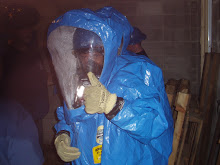 If you are asking yourself, “Am I required to train my employees under the HAZWOPER Standard?” this article can help you answer that question.
If you are asking yourself, “Am I required to train my employees under the HAZWOPER Standard?” this article can help you answer that question.
The Hazardous Waste Operations and Emergency Response Standard (HAZWOPER) applies to five distinct groups of employers and their employees. This includes any employees who are exposed or potentially exposed to hazardous substances — including hazardous waste — and who are engaged in one of the following operations as specified by 1910.120(a)(1)(i-v) and 1926.65(a)(1)(i-v):Clean-up Operations
required by a governmental body, whether Federal, state, local or other involving hazardous substances that are conducted at uncontrolled hazardous waste sites (including, but not limited to, the EPA’s National Priority Site List (NPL), state priority site lists, sites recommended for the EPA NPL, and initial investigations of government identified sites which are conducted before the presence or absence of hazardous substances has been ascertained)
Corrective Actions involving Clean-up Operations
sites covered by the Resource Conservation and Recovery Act of 1976 (RCRA) as amended (42 U.S.C. 6901 et seq.)
Voluntary Clean-up Operations
sites recognized by federal, state, local, or other governmental body as uncontrolled hazardous waste sites
Operations involving Hazardous Wastes
Operations conducted at treatment, storage, and disposal facilities regulated by Title 40 Code of Federal Regulations Parts 264 and 265 pursuant to RCRA, or by agencies under agreement with U.S. Environmental Protection Agency to implement RCRA regulations
Emergency Response Operations
releases of, or substantial threats of releases of, hazardous substances regardless of the location of the hazard
The first 4 of these 5 groups are specifically “hazardous waste sites”. The 5th group, “Emergency Response Operations” may be a bit more difficult to recognize because it applies to any area (factory, construction site, etc.) that uses or produces hazardous material for production or to perform their duties. Employees who are exposed or potentially exposed to hazardous substances — including hazardous waste — and who are engaged in emergency response operations for releases of, or substantial threats of releases of hazardous substances regardless of the location of the hazard are included in emergency response operations.How is “emergency response” defined? OSHA discusses this very topic in a Compliance Directive CPL 02-02-059, Appendix E.
An understanding of the distinction between an incidental release of a hazardous substance and a release that requires an emergency response is fundamental to proper compliance with the provisions of 29 CFR 1910.120(q). This part of the standard was written to cover a wide array of facilities and situations: “Emergency response operations for releases of, or substantial threats of releases of, hazardous substances without regard to the location of the hazard.” (29 CFR 1910.120(a)(1)(v))
Potential releases of hazardous substances in the workplace can be categorized into three distinct groups in terms of the planning provisions of 29 CFR 1910.120(q). These groups are:
1. Releases that are clearly incidental regardless of the circumstances
2. Releases that may be incidental or may require an emergency response depending on the circumstances
3. Releases that clearly require an emergency response regardless of the circumstances
This directive basically breaks down a spill response into “incidental” and “emergency response”. These two terms are defined in 29 CFR 1910.120(a)(3)
Emergency response or responding to emergencies means a response effort by employees from outside the immediate release area or by other designated responders (i.e., mutual aid groups, local fire departments, etc.) to an occurrence which results, or is likely to result, in an uncontrolled release of a hazardous substance.
Responses to incidental releases of hazardous substances where the substance can be absorbed, neutralized, or otherwise controlled at the time of release by employees in the immediate release area, or by maintenance personnel are not considered to be emergency responses within the scope of this standard. Responses to releases of hazardous substances where there is no potential safety or health hazard (i.e., fire, explosion, or chemical exposure) are not considered to be emergency responses.
If you are not sure which situation applies to you, give us a call 773 313 3012 We can walk you through the Risk Assessment process to determine if you need to train your employees to the requirements of the HAZWOPER standard.

